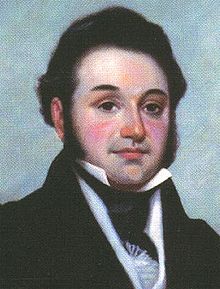
Back لورينزو دى زافالا ARZ Manuel Lorenzo Justiniano de Zavala y Sáenz German Lorenzo de Zavala Spanish Lorenzo de Zavala Basque لورنسو د ساوالا Persian Lorenzo de Zavala French Lorenzo de Zavala Hungarian Lorenzo de Zavala Italian Lorenzo de Zavala Dutch Lorenzo de Zavala NB
Lorenzo de Zavala | |
|---|---|
 | |
| Vice President of the Republic of Texas | |
Interim | |
| In office 16 March 1836 – 22 October 1836 | |
| President | David G. Burnet |
| Preceded by | Office established |
| Succeeded by | Mirabeau B. Lamar |
| Governor of the State of Mexico | |
| In office 15 August 1831 – 1 December 1832 | |
| President | Melchor Múzquiz |
| Succeeded by | Félix María Aburou |
| In office 8 March 1826 – 19 April 1826 | |
| President | Melchor Múzquiz |
| Succeeded by | Mariano Esteva y Ulibarri |
| Secretary of Finance of the United Mexican States | |
| In office 18 April 1829 – 2 November 1829 | |
| President | Francisco Moctezuma |
| Succeeded by | José María Bocanegra |
| Representative for Yucatán in the Congress of Deputies of Spain | |
| In office 1820–1822 | |
| Personal details | |
| Born | October 3, 1788 Tecoh, Yucatán, Viceroyalty of New Spain |
| Died | November 15, 1836 (aged 48) Channelview, Republic of Texas |
Manuel Lorenzo Justiniano de Zavala y Sánchez (October 3, 1788 – November 15, 1836), known simply as Lorenzo de Zavala, was a Mexican and later Tejano physician, politician, diplomat and author.[1] Born in Yucatán under Spanish rule, he was closely involved in drafting the constitution for the First Federal Republic of Mexico in 1824 after Mexico won independence from Spain. Years later, he also helped in drafting a constitution for Mexico's rebellious enemy at the time, the Republic of Texas, to secure independence from Mexico in 1836.[2] Zavala was said to have had a keen intellect and was fluent in multiple languages.[3]
Zavala was one of the most prominent liberals in the era of the First Republic.[4] Since his youth, Zavala was an indefatigable believer in the principle of democratic representative government.[5] As a young man he founded several newspapers and wrote extensively, espousing democratic reforms — writings which led to his imprisonment by the Spanish crown. While imprisoned, he learned English and studied medicine; after his release, he practiced medicine for two years before entering politics.[1]
Over his career, he served in many different capacities including the Spanish Cortes (legislature) in Madrid representing Yucatán, and in Mexico's Senate.[3] He became Mexico's Minister of Finance and served as Ambassador to France and Governor of the State of Mexico.[1] In 1829, a conservative coup brought Anastasio Bustamante to power, and Zavala was forced into exile, moving to the United States for two years. He wrote a book about U.S. political culture during this time and also traveled extensively in Europe. With his diplomatic experience and linguistic skills, Zavala was well received by foreign governments.[6]
In 1832, a liberal coup brought Valentin Gomez Farias to power. Zavala returned to Mexico and was appointed as Minister to France. While serving in Paris, Zavala witnessed overthrow of Gomez Farias and the subsequent fall of the First Mexican Republic. Santa Anna was in the process of setting up the Centralist Republic of Mexico, replacing the Mexican Constitution that Zavala himself had helped write. Zavala resigned his position in protest and spoke out against Santa Anna.[7] Zavala could not return home and fled to Texas, which like many Mexican provinces at the time, was rebelling against Santa Anna and the centralist constitution which intended to strip Mexican provinces of their autonomy. Zavala eventually became an advocate of Texas independence to the point of helping in the drafting of the Constitution of the Republic of Texas, personally designing its flag, and serving as vice president.[8]
Zavala's legacy in Mexico remains controversial with historians recognizing his political and intellectual work, his important role in the early history of the nation, while still branding him a traitor for helping the Texans secede from Mexico. Conversely, Texans consider him a founding father and state hero.[9] In modern-day Texas, both a county and a city are named in his honor, as well as many schools and public buildings including the Texas State Archives and Library Building in Austin.
- ^ a b c "A Guide to the Lorenzo De Zavala Papers, 1818-1936". lib.utexas.edu. Dolph Briscoe Center for American History, The University of Texas at Austin. Retrieved 2 February 2017.
- ^ "Lorenzo de Zavala (1789-1836)". lsjunction.com. Lone Star Junction. Retrieved 23 January 2017.
- ^ a b Fitzpatrick, Vale. "The Portal to Texas History/Lorenzo de Zavala Online: Impresario, Statesman and Texas Revolutionary". education.texashistory.unt.edu. University of North Texas Libraries. Retrieved 24 January 2017.
- ^ Fehrenbach, T.R. (1995). Fire and Blood: A History of Mexico. Da Capo Press. p. 367. ISBN 9780306806285.
- ^ Lozano, Reuben R. "The Mexican Texans and their Activities/Lorenzo de Zavala". tamu.edu/faculty (Texas A&M University). Wallace L. McKeehan. Retrieved 27 January 2017.
- ^ "Texas A&M University/Sons of Dewitt Colony Texas". tamu.edu. Wallace L. McKeehan. Retrieved 23 January 2017.
- ^ "Lorenzo de Zavala". tsl.texas.gov. Texas State Library and Archives Commission. Retrieved 21 January 2017.
- ^ Estep, Raymond (May 31, 2016). "Handbook of Texas Online/Zavala, Lorenzo de". tshaonline.org. Texas State Historical Association. Retrieved 20 January 2017.
- ^ TexasTejano - Texas Heritage Revival Announcement
© MMXXIII Rich X Search. We shall prevail. All rights reserved. Rich X Search